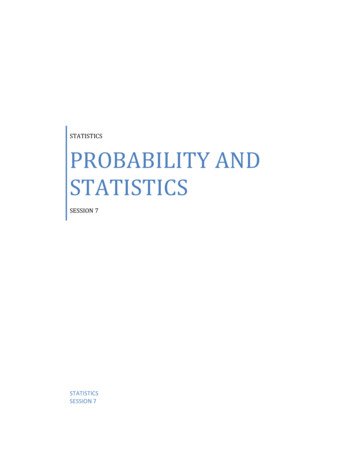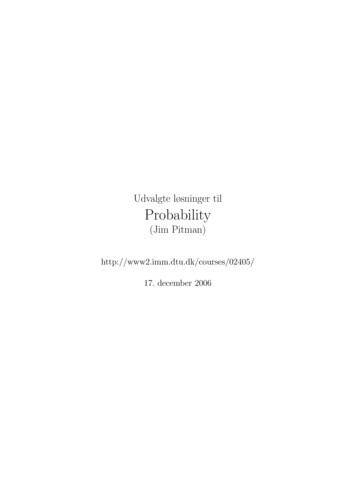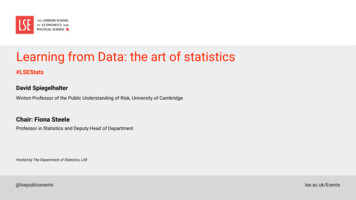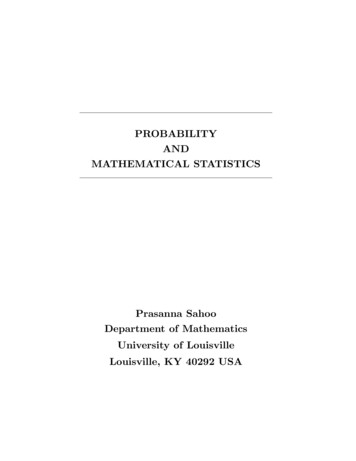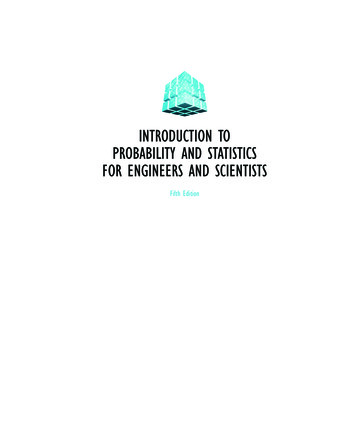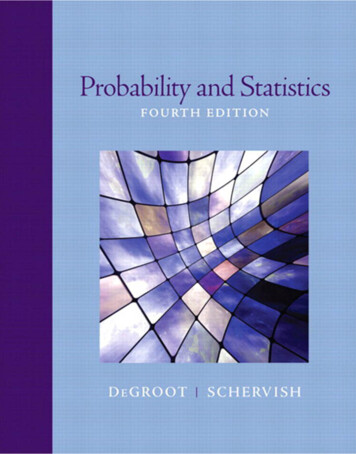
Transcription
Probability and StatisticsFourth Edition
This page intentionally left blank
Probability and StatisticsFourth EditionMorris H. DeGrootCarnegie Mellon UniversityMark J. SchervishCarnegie Mellon UniversityAddison-WesleyBoston Columbus Indianapolis New York San Francisco Upper Saddle RiverAmsterdam Cape Town Dubai London Madrid Milan Munich Paris Montréal TorontoDelhi Mexico City São Paulo Sydney Hong Kong Seoul Singapore Taipei Tokyo
Editor in Chief: Deirdre LynchAcquisitions Editor: Christopher CummingsAssociate Content Editors: Leah Goldberg, Dana Jones BettezAssociate Editor: Christina LepreSenior Managing Editor: Karen WernholmProduction Project Manager: Patty BerginCover Designer: Heather ScottDesign Manager: Andrea NixSenior Marketing Manager: Alex GayMarketing Assistant: Kathleen DeChavezSenior Author Support/Technology Specialist: Joe VetereRights and Permissions Advisor: Michael JoyceManufacturing Manager: Carol MelvilleProject Management, Composition: Windfall Software, using ZzTEXCover Photo: Shutterstock/ Marilyn VolanThe programs and applications presented in this book have been included for their instructional value. They have been tested with care, but are not guaranteed for any particularpurpose. The publisher does not offer any warranties or representations, nor does it acceptany liabilities with respect to the programs or applications.Many of the designations used by manufacturers and sellers to distinguish their products areclaimed as trademarks. Where those designations appear in this book, and Pearson Educationwas aware of a trademark claim, the designations have been printed in initial caps or all caps.Library of Congress Cataloging-in-Publication DataDeGroot, Morris H., 1931–1989.Probability and statistics / Morris H. DeGroot, Mark J. Schervish.—4th ed.p. cm.ISBN 978-0-321-50046-51. Probabilities—Textbooks. 2. Mathematical statistics—Textbooks.I. Schervish, Mark J. II. Title.QA273.D35 2012519.2—dc222010001486Copyright 2012, 2002 Pearson Education, Inc.All rights reserved. No part of this publication may be reproduced, stored in a retrieval system,or transmitted, in any form or by any means, electronic, mechanical, photocopying, recording,or otherwise, without the prior written permission of the publisher. Printed in the UnitedStates of America. For information on obtaining permission for use of material in this work,please submit a written request to Pearson Education, Inc., Rights and Contracts Department,75 Arlington Street, Suite 300, Boston, MA 02116, fax your request to 617-848-7047, or e-mailat http://www.pearsoned.com/legal/permissions.htm.1 2 3 4 5 6 7 8 9 10—EB—14 13 12 11 10ISBN 10: 0-321-50046-6www.pearsonhighered.comISBN 13: 978-0-321-50046-5
To the memory of Morrie DeGroot.MJS
This page intentionally left blank
ContentsPreface1xiIntroduction to Probability1.1The History of Probability1.2Interpretations of Probability1.3Experiments and Events1.4Set Theory1.5The Definition of Probability1.6Finite Sample Spaces1.7Counting Methods1.8Combinatorial Methods1.9Multinomial Coefficients1125616222532421.10 The Probability of a Union of Events1.11 Statistical Swindles511.12 Supplementary Exercises253Conditional Probability552.1The Definition of Conditional Probability2.2Independent Events2.3Bayes’ Theorem 2.42.5346556676The Gambler’s Ruin ProblemSupplementary Exercises8690Random Variables and Distributions3.1Random Variables and Discrete Distributions3.2Continuous Distributions3.3The Cumulative Distribution Function3.4Bivariate Distributions1183.5Marginal Distributions1303.6Conditional Distributions1413.7Multivariate Distributions1523.8Functions of a Random Variable3.9Functions of Two or More Random Variables 3.10 Markov Chains1001883.11 Supplementary Exercisesvii9320210716717593
viiiContents4Expectation4.1The Expectation of a Random Variable4.2Properties of Expectations4.3Variance4.4Moments4.5The Mean and the Median2414.6Covariance and Correlation2484.7Conditional Expectation 4.84.95207Utility217225234256265Supplementary Exercises272Special Distributions2755.1Introduction5.2The Bernoulli and Binomial Distributions5.3The Hypergeometric Distributions5.4The Poisson Distributions5.5The Negative Binomial Distributions5.6The Normal Distributions3025.7The Gamma Distributions3165.8The Beta Distributions5.9The Multinomial Distributions2752872973275.11 Supplementary Exercises7333337345Large Random Samples3476.1Introduction6.2The Law of Large Numbers3486.3The Central Limit Theorem3606.4The Correction for Continuity6.5Supplementary ExercisesEstimation2752815.10 The Bivariate Normal Distributions62073473713753767.1Statistical Inference7.2Prior and Posterior Distributions7.3Conjugate Prior Distributions7.4Bayes Estimators376408385394
Contents7.5Maximum Likelihood Estimators7.6Properties of Maximum Likelihood Estimators 7.7Sufficient Statistics 7.8Jointly Sufficient Statistics 7.9Improving an Estimator449455461Sampling Distributions of EstimatorsThe Sampling Distribution of a Statistic8.2The Chi-Square Distributions8.3Joint Distribution of the Sample Mean and Sample Variance8.4The t Distributions8.5Confidence Intervals8.7 8.88.9464469485Bayesian Analysis of Samples from a Normal DistributionUnbiased EstimatorsFisher Information473480495506514Supplementary Exercises528Testing Hypotheses9.1530Problems of Testing Hypotheses 9.2Testing Simple Hypotheses 9.3Uniformly Most Powerful Tests 9.4Two-Sided Alternatives5305505595679.5The t Test9.6Comparing the Means of Two Normal Distributions9.7The F Distributions576 9.8Bayes Test Procedures 9.9Foundational Issues5875976056179.10 Supplementary Exercises104648.1 8.694264437.10 Supplementary Exercises8417621Categorical Data and Nonparametric Methods10.1 Tests of Goodness-of-Fit62410.2 Goodness-of-Fit for Composite Hypotheses10.3 Contingency Tables64110.4 Tests of Homogeneity10.5 Simpson’s Paradox647653 10.6 Kolmogorov-Smirnov Tests657633624ix
xContents 10.7 Robust Estimation 10.8 Sign and Rank Tests66667810.9 Supplementary Exercises11686Linear Statistical Models11.1 The Method of Least Squares11.2 Regression68968969811.3 Statistical Inference in Simple Linear Regression 11.4 Bayesian Inference in Simple Linear Regression11.5 The General Linear Model and Multiple Regression11.6 Analysis of Variance754 11.7 The Two-Way Layout763 11.8 The Two-Way Layout with Replications11.9 Supplementary Exercises12Simulation78378712.1 What Is Simulation?78712.2 Why Is Simulation Useful?79112.3 Simulating Specific Distributions80412.4 Importance Sampling816 12.5 Markov Chain Monte Carlo82312.6 The Bootstrap83912.7 Supplementary ExercisesTables850853Answers to Odd-Numbered ExercisesReferencesIndex879885865772707729736
PrefaceChanges to the Fourth Edition.I have reorganized many main results that were included in the body of thetext by labeling them as theorems in order to facilitate students in finding andreferencing these results.I have pulled the important defintions and assumptions out of the body of thetext and labeled them as such so that they stand out better.When a new topic is introduced, I introduce it with a motivating example beforedelving into the mathematical formalities. Then I return to the example toillustrate the newly introduced material.I moved the material on the law of large numbers and the central limit theoremto a new Chapter 6. It seemed more natural to deal with the main large-sampleresults together.I moved the section on Markov chains into Chapter 3. Every time I cover thismaterial with my own students, I stumble over not being able to refer to randomvariables, distributions, and conditional distributions. I have actually postponedthis material until after introducing distributions, and then gone back to coverMarkov chains. I feel that the time has come to place it in a more naturallocation. I also added some material on stationary distributions of Markovchains.I have moved the lengthy proofs of several theorems to the ends of theirrespective sections in order to improve the flow of the presentation of ideas.I rewrote Section 7.1 to make the introduction to inference clearer.I rewrote Section 9.1 as a more complete introduction to hypothesis testing,including likelihood ratio tests. For instructors not interested in the more mathematical theory of hypothesis testing, it should now be easier to skip fromSection 9.1 directly to Section 9.5.Some other changes that readers will notice:.I have replaced the notation in which the intersection of two sets A and B hadbeen represented AB with the more popular A B. The old notation, althoughmathematically sound, seemed a bit arcane for a text at this level.I added the statements of Stirling’s formula and Jensen’s inequality.I moved the law of total probability and the discussion of partitions of a samplespace from Section 2.3 to Section 2.1.I define the cumulative distribution function (c.d.f.) as the prefered name ofwhat used to be called only the distribution function (d.f.).I added some discussion of histograms in Chapters 3 and 6.I rearranged the topics in Sections 3.8 and 3.9 so that simple functions of randomvariables appear first and the general formulations appear at the end to makeit easier for instructors who want to avoid some of the more mathematicallychallenging parts.I emphasized the closeness of a hypergeometric distribution with a large number of available items to a binomial distribution.xi
xiiPreface.I gave a brief introduction to Chernoff bounds. These are becoming increasinglyimportant in computer science, and their derivation requires only material thatis already in the text.I changed the definition of confidence interval to refer to the random intervalrather than the observed interval. This makes statements less cumbersome, andit corresponds to more modern usage.I added a brief discussion of the method of moments in Section 7.6.I added brief introductions to Newton’s method and the EM algorithm inChapter 7.I introduced the concept of pivotal quantity to facilitate construction of confidence intervals in general.I added the statement of the large-sample distribution of the likelihood ratiotest statistic. I then used this as an alternative way to test the null hypothesisthat two normal means are equal when it is not assumed that the variances areequal.I moved the Bonferroni inequality into the main text (Chapter 1) and later(Chapter 11) used it as a way to construct simultaneous tests and confidenceintervals.How to Use This BookThe text is somewhat long for complete coverage in a one-year course at the undergraduate level and is designed so that instructors can make choices about which topicsare most important to cover and which can be left for more in-depth study. As an example, many instructors wish to deemphasize the classical counting arguments thatare detailed in Sections 1.7–1.9. An instructor who only wants enough informationto be able to cover the binomial and/or multinomial distributions can safely discuss only the definitions and theorems on permutations, combinations, and possiblymultinomial coefficients. Just make sure that the students realize what these valuescount, otherwise the associated distributions will make no sense. The various examples in these sections are helpful, but not necessary, for understanding the importantdistributions. Another example is Section 3.9 on functions of two or more randomvariables. The use of Jacobians for general multivariate transformations might bemore mathematics than the instructors of some undergraduate courses are willingto cover. The entire section could be skipped without causing problems later in thecourse, but some of the more straightforward cases early in the section (such as convolution) might be worth introducing. The material in Sections 9.2–9.4 on optimaltests in one-parameter families is pretty mathematics, but it is of interest primarilyto graduate students who require a very deep understanding of hypothesis testingtheory. The rest of Chapter 9 covers everything that an undergraduate course reallyneeds.In addition to the text, the publisher has an Instructor’s Solutions Manual, available for download from the Instructor Resource Center at www.pearsonhighered.com/irc, which includes some specific advice about many of the sections of the text.I have taught a year-long probability and statistics sequence from earlier editions ofthis text for a group of mathematically well-trained juniors and seniors. In the firstsemester, I covered what was in the earlier edition but is now in the first five chapters (including the material on Markov chains) and parts of Chapter 6. In the secondsemester, I covered the rest of the new Chapter 6, Chapters 7–9, Sections 11.1–11.5,and Chapter 12. I have also taught a one-semester probability and random processes
Prefacexiiicourse for engineers and computer scientists. I covered what was in the old editionand is now in Chapters 1–6 and 12, including Markov chains, but not Jacobians. Thislatter course did not emphasize mathematical derivation to the same extent as thecourse for mathematics students.A number of sections are designated with an asterisk (*). This indicates thatlater sections do not rely materially on the material in that section. This designationis not intended to suggest that instructors skip these sections. Skipping one of thesesections will not cause the students to miss definitions or results that they will needlater. The sections are 2.4, 3.10, 4.8, 7.7, 7.8, 7.9, 8.6, 8.8, 9.2, 9.3, 9.4, 9.8, 9.9, 10.6,10.7, 10.8, 11.4, 11.7, 11.8, and 12.5. Aside from cross-references between sectionswithin this list, occasional material from elsewhere in the text does refer back tosome of the sections in this list. Each of the dependencies is quite minor, however.Most of the dependencies involve references from Chapter 12 back to one of theoptional sections. The reason for this is that the optional sections address some ofthe more difficult material, and simulation is most useful for solving those difficultproblems that cannot be solved analytically. Except for passing references that helpput material into context, the dependencies are as follows:.The sample distribution function (Section 10.6) is reintroduced during thediscussion of the bootstrap in Section 12.6. The sample distribution functionis also a useful tool for displaying simulation results. It could be introduced asearly as Example 12.3.7 simply by covering the first subsection of Section 10.6.The material on robust estimation (Section 10.7) is revisited in some simulationexercises in Section 12.2 (Exercises 4, 5, 7, and 8).Example 12.3.4 makes reference to the material on two-way analysis of variance(Sections 11.7 and 11.8).SupplementsThe text is accompanied by the following supplementary material:.Instructor’s Solutions Manual contains fully worked solutions to all exercisesin the text. Available for download from the Instructor Resource Center atwww.pearsonhighered.com/irc.Student Solutions Manual contains fully worked solutions to all odd exercises inthe text. Available for purchase from MyPearsonStore at www.mypearsonstore.com. (ISBN-13: 978-0-321-71598-2; ISBN-10: 0-321-71598-5)AcknowledgmentsThere are many people that I want to thank for their help and encouragement duringthis revision. First and foremost, I want to thank Marilyn DeGroot and Morrie’schildren for giving me the chance to revise Morrie’s masterpiece.I am indebted to the many readers, reviewers, colleagues, staff, and peopleat Addison-Wesley whose help and comments have strengthened this edition. Thereviewers were:Andre Adler, Illinois Institute of Technology; E. N. Barron, Loyola University; BrianBlank, Washington University in St. Louis; Indranil Chakraborty, University of Oklahoma; Daniel Chambers, Boston College; Rita Chattopadhyay, Eastern MichiganUniversity; Stephen A. Chiappari, Santa Clara University; Sheng-Kai Chang, WayneState University; Justin Corvino, Lafayette College; Michael Evans, University of
xivPrefaceToronto; Doug Frank, Indiana University of Pennsylvania; Anda Gadidov, Kennesaw State University; Lyn Geisler, Randolph–Macon College; Prem Goel, OhioState University; Susan Herring, Sonoma State University; Pawel Hitczenko, DrexelUniversity; Lifang Hsu, Le Moyne College; Wei-Min Huang, Lehigh University;Syed Kirmani, University of Northern Iowa; Michael Lavine, Duke University; RichLevine, San Diego State University; John Liukkonen, Tulane University; SergioLoch, Grand View College; Rosa Matzkin, Northwestern University; Terry McConnell, Syracuse University; Hans-Georg Mueller, University of California–Davis;Robert Myers, Bethel College; Mario Peruggia, The Ohio State University; StefanRalescu, Queens University; Krishnamurthi Ravishankar, SUNY New Paltz; DianeSaphire, Trinity University; Steven Sepanski, Saginaw Valley State University; HenSiong Tan, Pennsylvania University; Kanapathi Thiru, University of Alaska; Kenneth Troske, Johns Hopkins University; John Van Ness, University of Texas at Dallas; Yehuda Vardi, Rutgers University; Yelena Vaynberg, Wayne State University;Joseph Verducci, Ohio State University; Mahbobeh Vezveai, Kent State University;Brani Vidakovic, Duke University; Karin Vorwerk, Westfield State College; BetteWarren, Eastern Michigan University; Calvin L. Williams, Clemson University; LoriWolff, University of Mississippi.The person who checked the accuracy of the book was Anda Gadidov, Kennesaw State University. I would also like to thank my colleagues at Carnegie MellonUniversity, especially Anthony Brockwell, Joel Greenhouse, John Lehoczky, HeidiSestrich, and Valerie Ventura.The people at Addison-Wesley and other organizations that helped producethe book were Paul Anagnostopoulos, Patty Bergin, Dana Jones Bettez, ChrisCummings, Kathleen DeChavez, Alex Gay, Leah Goldberg, Karen Hartpence, andChristina Lepre.If I left anyone out, it was unintentional, and I apologize. Errors inevitably arisein any project like this (meaning a project in which I am involved). For this reason,I shall post information about the book, including a list of corrections, on my Webpage, http://www.stat.cmu.edu/ mark/, as soon as the book is published. Readers areencouraged to send me any errors that they discover.Mark J. SchervishOctober 2010
Chapter1Introduction toProbability1.11.21.31.41.51.6The History of ProbabilityInterpretations of ProbabilityExperiments and EventsSet TheoryThe Definition of ProbabilityFinite Sample Spaces1.71.81.91.101.111.12Counting MethodsCombinatorial MethodsMultinomial CoefficientsThe Probability of a Union of EventsStatistical SwindlesSupplementary Exercises1.1 The History of ProbabilityThe use of probability to measure uncertainty and variability dates back hundredsof years. Probability has found application in areas as diverse as medicine, gambling, weather forecasting, and the law.The concepts of chance and uncertainty are as old as civilization itself. People havealways had to cope with uncertainty about the weather, their food supply, and otheraspects of their environment, and have striven to reduce this uncertainty and itseffects. Even the idea of gambling has a long history. By about the year 3500 b.c.,games of chance played with bone objects that could be considered precursors ofdice were apparently highly developed in Egypt and elsewhere. Cubical dice withmarkings virtually identical to those on modern dice have been found in Egyptiantombs dating from 2000 b.c. We know that gambling with dice has been popular eversince that time and played an important part in the early development of probabilitytheory.It is generally believed that the mathematical theory of probability was started bythe French mathematicians Blaise Pascal (1623–1662) and Pierre Fermat (1601–1665)when they succeeded in deriving exact probabilities for certain gambling problemsinvolving dice. Some of the problems that they solved had been outstanding for about300 years. However, numerical probabilities of various dice combinations had beencalculated previously by Girolamo Cardano (1501–1576) and Galileo Galilei (1564–1642).The theory of probability has been developed steadily since the seventeenthcentury and has been widely applied in diverse fields of study. Today, probabilitytheory is an important tool in most areas of engineering, science, and management.Many research workers are actively engaged in the discovery and establishment ofnew applications of probability in fields such as medicine, meteorology, photographyfrom satellites, marketing, earthquake prediction, human behavior, the design ofcomputer systems, finance, genetics, and law. In many legal proceedings involvingantitrust violations or employment discrimination, both sides will present probabilityand statistical calculations to help support their cases.1
2Chapter 1 Introduction to ProbabilityReferencesThe ancient history of gambling and the origins of the mathematical theory of probability are discussed by David (1988), Ore (1960), Stigler (1986), and Todhunter(1865).Some introductory books on probability theory, which discuss many of the sametopics that will be studied in this book, are Feller (1968); Hoel, Port, and Stone (1971);Meyer (1970); and Olkin, Gleser, and Derman (1980). Other introductory books,which discuss both probability theory and statistics at about the same level as theywill be discussed in this book, are Brunk (1975); Devore (1999); Fraser (1976); Hoggand Tanis (1997); Kempthorne and Folks (1971); Larsen and Marx (2001); Larson(1974); Lindgren (1976); Miller and Miller (1999); Mood, Graybill, and Boes (1974);Rice (1995); and Wackerly, Mendenhall, and Schaeffer (2008).1.2 Interpretations of ProbabilityThis section describes three common operational interpretations of probability.Although the interpretations may seem incompatible, it is fortunate that the calculus of probability (the subject matter of the first six chapters of this book) appliesequally well no matter which interpretation one prefers.In addition to the many formal applications of probability theory, the concept ofprobability enters our everyday life and conversation. We often hear and use suchexpressions as “It probably will rain tomorrow afternoon,” “It is very likely thatthe plane will arrive late,” or “The chances are good that he will be able to join usfor dinner this evening.” Each of these expressions is based on the concept of theprobability, or the likelihood, that some specific event will occur.Despite the fact that the concept of probability is such a common and naturalpart of our experience, no single scientific interpretation of the term probability isaccepted by all statisticians, philosophers, and other authorities. Through the years,each interpretation of probability that has been proposed by some authorities hasbeen criticized by others. Indeed, the true meaning of probability is still a highlycontroversial subject and is involved in many current philosophical discussions pertaining to the foundations of statistics. Three different interpretations of probabilitywill be described here. Each of these interpretations can be very useful in applyingprobability theory to practical problems.The Frequency Interpretation of ProbabilityIn many problems, the probability that some specific outcome of a process will beobtained can be interpreted to mean the relative frequency with which that outcomewould be obtained if the process were repeated a large number of times under similarconditions. For example, the probability of obtaining a head when a coin is tossed isconsidered to be 1/2 because the relative frequency of heads should be approximately1/2 when the coin is tossed a large number of times under similar conditions. In otherwords, it is assumed that the proportion of tosses on which a head is obtained wouldbe approximately 1/2.Of course, the conditions mentioned in this example are too vague to serve as thebasis for a scientific definition of probability. First, a “large number” of tosses of thecoin is specified, but there is no definite indication of an actual number that would
1.2 Interpretations of Probability3be considered large enough. Second, it is stated that the coin should be tossed eachtime “under similar conditions,” but these conditions are not described precisely. Theconditions under which the coin is tossed must not be completely identical for eachtoss because the outcomes would then be the same, and there would be either allheads or all tails. In fact, a skilled person can toss a coin into the air repeatedly andcatch it in such a way that a head is obtained on almost every toss. Hence, the tossesmust not be completely controlled but must have some “random” features.Furthermore, it is stated that the relative frequency of heads should be “approximately 1/2,” but no limit is specified for the permissible variation from 1/2. If a coinwere tossed 1,000,000 times, we would not expect to obtain exactly 500,000 heads.Indeed, we would be extremely surprised if we obtained exactly 500,000 heads. Onthe other hand, neither would we expect the number of heads to be very far from500,000. It would be desirable to be able to make a precise statement of the likelihoods of the different possible numbers of heads, but these likelihoods would ofnecessity depend on the very concept of probability that we are trying to define.Another shortcoming of the frequency interpretation of probability is that itapplies only to a problem in which there can be, at least in principle, a large number ofsimilar repetitions of a certain process. Many important problems are not of this type.For example, the frequency interpretation of probability cannot be applied directlyto the probability that a specific acquaintance will get married within the next twoyears or to the probability that a particular medical research project will lead to thedevelopment of a new treatment for a certain disease within a specified period of time.The Classical Interpretation of ProbabilityThe classical interpretation of probability is based on the concept of equally likelyoutcomes. For example, when a coin is tossed, there are two possible outcomes: ahead or a tail. If it may be assumed that these outcomes are equally likely to occur,then they must have the same probability. Since the sum of the probabilities mustbe 1, both the probability of a head and the probability of a tail must be 1/2. Moregenerally, if the outcome of some process must be one of n different outcomes, andif these n outcomes are equally likely to occur, then the probability of each outcomeis 1/n.Two basic difficulties arise when an attempt is made to develop a formal definition of probability from the classical interpretation. First, the concept of equallylikely outcomes is essentially based on the concept of probability that we are tryingto define. The statement that two possible outcomes are equally likely to occur is thesame as the statement that two outcomes have the same probability. Second, no systematic method is given for assigning probabilities to outcomes that are not assumedto be equally likely. When a coin is tossed, or a well-balanced die is rolled, or a card ischosen from a well-shuffled deck of cards, the different possible outcomes can usuallybe regarded as equally likely because of the nature of the process. However, when theproblem is to guess whether an acquaintance will get married or whether a researchproject will be successful, the possible outcomes would not typically be consideredto be equally likely, and a different method is needed for assigning probabilities tothese outcomes.The Subjective Interpretation of ProbabilityAccording to the subjective, or personal, interpretation of probability, the probabilitythat a person assigns to a possible outcome of some process represents her own
4Chapter 1 Introduction to Probabilityjudgment of the likelihood that the outcome will be obtained. This judgment will bebased on each person’s beliefs and information about the process. Another person,who may have different beliefs or different information, may assign a differentprobability to the same outcome. For this reason, it is appropriate to speak of acertain person’s subjective probability of an outcome, rather than to speak of thetrue probability of that outcome.As an illustration of this interpretation, suppose that a coin is to be tossed once.A person with no special information about the coin or the way in which it is tossedmight regard a head and a tail to be equally likely outcomes. That person wouldthen assign a subjective probability of 1/2 to the possibility of obtaining a head. Theperson who is actually tossing the coin, however, might feel that a head is muchmore likely to be obtained than a tail. In order that people in general may be ableto assign subjective probabilities to the outcomes, they must express the strength oftheir belief in numerical terms. Suppose, for example, that they regard the likelihoodof obtaining a head to be the same as the likelihood of obtaining a red card when onecard is chosen from a well-shuffled deck containing four red cards and one black card.Because those people would assign a probability of 4/5 to the possibility of obtaininga red card, they should also assign a probability of 4/5 to the possibility of obtaininga head when the coin is tossed.This subjective interpretation of probability can be formalized. In general, ifpeople’s judgments of the relative likelihoods of various combinations of outcomessatisfy certain conditions of consistency, then it can be shown that their subjectiveprobabilities of the different possible events can be uniquely determined. However,there are two difficulties with the subjective interpretation. First, the requirementthat a person’s judgments of the relative likelihoods of an infinite number of eventsbe completely consistent and free from contradictions does not
Contents Preface xi 1 Introduction to Probability 1 1.1 The History of Probability 1 1.2 Interpretations of Probability 2 1.3 Experiments and Events 5 1.4 Set Theory 6 1.5 The Definition of Probability 16 1.6 Finite Sample Spaces 22 1.7 Counting Methods 25 1.8 Combinatorial Methods 32 1.9 Multinomial Coefficien

